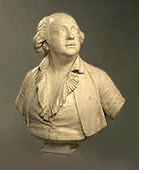...Best of Sicily
presents... Best of Sicily Magazine. ... Dedicated to Sicilian art, culture, history, people, places and all things Sicilian. |
by Vincenzo Salerno | ||
Magazine Best of Sicily Arts & Culture Fashion Food & Wine History & Culture About Us Travel Faqs Contact Map of Sicily |
Which historical figure could be said to be the embodiment of the Sicilian capital, the very archetypal exemplar of the "Palermitanism" for which the city is famous today? The most obvious choice is the eighteenth century charlatan, imposter, alchemist, arch-deceiver and all-around "flim-flam" man, the so-called Count of Cagliostro. Not surprisingly, his name was not Cagliostro and he was not a count. To be sure, the Post-Baroque era of "European Enlightenment" produced more than its share of scoundrels and swindlers, in real life as well as fiction --Franz Anton Mesmer, Emmanuel Swedenborg, Tom Jones and Barry Lyndon, to mention a few. Some had their merits, to be sure. But above them all stands Cagliostro. His beginnings were both prosaic and humble. Born in 1743 as Giuseppe Balsamo in Palermo's Albergheria district, formerly the old Jewish Quarter, he spent his youth as a street urchin. Afforded an education, he learned some chemistry and the rudiments of medicine at a monastery but was forced to flee Palermo when accused of murder following a petty theft and forgery spree. As they say, a prophet is never appreciated in his own country. Arriving in the thriving city of Naples, Giuseppe discovered a potential clientele far greater than anything in Sicily. (Naples was then the third largest European city after Paris and London.) He wed the beautiful Lorenza Feliciani, a young woman of extraordinary beauty and grace and, like Balsamo, boundless ambition. Moving beyond Naples, they decided to work as a team of con-artists amongst the gullible and thrill-seeking Continental aristocracy. Alchemy, magic and mysticism were their stock and trade. In 1771 they became purveyors of "immortal youth" and Lorenza's amorous charms. His young wife was purported to be a woman of sixty, and yet with the help of their miracle elixir she allegedly retained her youth, grace and sexual vigor. The shrewd Count of Cagliostro, as he now styled himself, was also quite busy as a faith healer, mystical philosopher, alchemist and necromancer. He even earned the trust of the discerning Cardinal de Rohan, to whom he claimed to have witnessed Jesus' crucifixion by using the the special elixir! Cagliostro's natural gregariousness, and ever-growing need for cash, motivated him to found several clubs devoted to "ancient Egyptian" freemasonry. With a growing demand for his services by wealthy clerics, statesmen and noblemen, Balsamo became ever wealthier and avaricious. His adventures took him across Europe, as far as Saint Petersburg. A master of deception, he remained in one place just long enough to make a good impression without being called upon to produce tangible results. By 1785, good sense and healthy skepticism began to uncover Balsamo's pretensions. A scandal in Paris prompted the authorities to investigate Cagliostro. He was imprisoned in the Bastille and, when released, ordered to leave France. During his incarceration, Balsamo's notoriety spread throughout Europe. By the time he returned to Italy, even the Holy Inquisition was after him, his wife having denounced him as a heretic to save her own skin. The Catholic authorities apprehended him in 1789. Instead of death, he was imprisoned for life in the San Leo Prison in Urbino. There he remained until his death six years later. He never saw Palermo again. The people of Balsamo's city named a street after their folk hero, where, in typical Cagliostro fashion, they identified a house as his birthplace without having any factual indication that he had ever lived there. The street, Via Cagliostro, was meant to be a tourist attraction. It has become a home for cats and rats. Yes, Giuseppe Balsamo truly typifies the spirit of Palermo --or should it be called "Cagliostroville?" About the Author: Palermo native Vincenzo Salerno has written biographies of several famous Sicilians, including Frederick II and Giuseppe di Lampedusa. | |
Top of Page |
 Every Italian city has its saintly protector, and also its own not-so-saintly one: Politician Niccolò Macchiavelli
of Florence, seducer Giacomo Casanova of Venice, comedian Totò (Antonio
de Curtis) of Naples. Some would say that the secular folk hero embodies
a city's true spirit as no patron saint ever could. With the passing centuries,
he becomes the true model for his fellow citizens. Duiring his lifetime,
however, the native son is loved because he seems to typify the people of
his city. He is the classic "local boy who makes good" in a larger
world.
Every Italian city has its saintly protector, and also its own not-so-saintly one: Politician Niccolò Macchiavelli
of Florence, seducer Giacomo Casanova of Venice, comedian Totò (Antonio
de Curtis) of Naples. Some would say that the secular folk hero embodies
a city's true spirit as no patron saint ever could. With the passing centuries,
he becomes the true model for his fellow citizens. Duiring his lifetime,
however, the native son is loved because he seems to typify the people of
his city. He is the classic "local boy who makes good" in a larger
world.